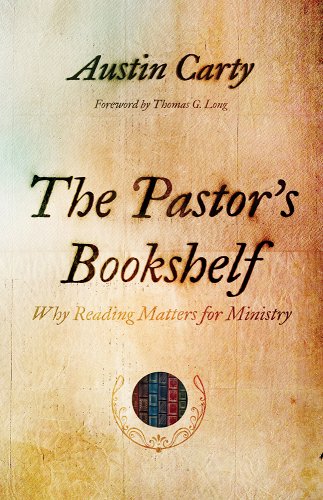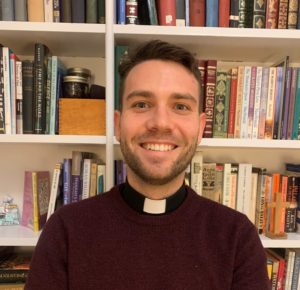New Brunswick, Canada. Austin Carty, one-time contestant on the popular reality TV show Survivor and now pastor of Boulevard Baptist Church, has given me permission to read more books at church. Not just theology books, mind you, but all kinds of books: novels, nonfiction, poetry – anything, really. I am grateful for the permission, but I am not sure if I’m the one he should be writing for.
In his slim new monograph, The Pastor’s Bookshelf: Why Reading Matters for Ministry, Carty makes the case that “reading not only makes us better pastors but also makes us better people” (4). His volume takes its place on the shelf with other books about books – think along the lines of Karen Swallow Prior’s On Reading Well and Alan Jacob’s The Pleasures of Reading in an Age of Distraction. Carty is writing to vocational ministers, of course – which is what makes his contribution unique – and throughout he argues that reading has the power to form us for ministry and enrich our lives. I agree.
Writing in an approachable and conversational style, Carty weaves in anecdotes from his own ministry with insights from psychology and literature, making the case that pastors ought to be readers. He divides the book into thirds. After a short foreword by Thomas G. Long, some acknowledgments, and a brief introduction, the first third (chapters 1-5) defines and describes what a “pastor-reader” is. The second third (chapters 6-9) situates the value of reading in particular ministry contexts such as pastoral visiting and preaching. And finally, section three (chapters 10-15) aims to be more practical, giving tips and insights on how to read well. These range from exhortations to read with an humble spirit to examples of how the pastor might catalogue her reading.
I really enjoyed reading this book. It was a delight. Some of the bits I enjoyed most were in Carty’s first chapter, “On Formation,” in which he details the way that “reading is far more about formation than information” (15). His point is that, despite only retaining a fraction of the content that we read, devoting attention to “wide, regular reading” is a means of helping us “remain anchored and poised in the face of an increasingly complicated and anxious world,” which is “one of the most vital things a pastor can offer his or her congregation today” (16). I am inclined to agree.
Or chapter six, “Reading for Preaching,” was a lovely reminder that edifying sermons can only grow out of rich soil and that the nutrition of the soil is maintained by a meandering reading life. Carty writes, “the only way for us as preachers to have access to such ‘fitting’ quotes and such ‘life-breathing’ images is to read long enough, and widely enough, and committedly enough to have a reservoir that, even when we don’t realize it, is all the while collecting these things, a reservoir from which they will emerge when we need them most” (71).
I appreciated “Choosing What to Read,” chapter thirteen, as well. It is an articulation of a phenomenon that many of us have experienced – the way that the right books just seemed to show up in our lives. Perhaps it’s just serendipity, but I think Carty is on to something by calling the way books make their way to us a “pneumatology of reading.” He believes “the Holy Spirit plays a central (though intrinsically mysterious) role in directing us as pastor-readers toward what—and when, and why—to read” (128). This rings true to my experience.
So, I like what Carty is up to here. But I am also not sure if his primary audience of pastors are the ones who need to read this book. There are two reasons for this. First, I suspect that those of us who are interested in a book titled The Pastor’s Bookshelf are the ones who are already committed to the reading life. We are a minority amongst ministers in any tradition, because all too often the pastorate is diminished to mechanization (if we run program a, then outcome b will follow) or is thought of like a factory job (if we do the preliminary training, figure out the job, then we can switch on autopilot for the rest of our careers). But those of us who are going to read this book will likely be reading the others Carty most often cites as well. If most pastors don’t have time for Dostoyevsky (a scandal if they do not!) they are not going to have time for the most recent publications from the Eerdmans’ catalogue.
But there is a second reason that pastors might not need to read this book. If a pastor is not a pastor-reader, I suspect it has quite a lot to do with the expectations of denominational leaders, vestries, and congregational boards. A book like Carty’s written for those who work with and support priests and pastors will have far more weight because the culture of an institution – whether it is a parish or denomination – will be shaped by the expectations of administrators and leaders who stick around long after the pastor has moved on to his next call. I think that the expectation is that most pastors ought not to spend hours each week reading novels and poetry during “office hours,” especially if they cannot point to any tangible reason for doing so. And to convince most churches otherwise would probably mean (sadly) crafting a catchy video series explaining the value of reading rather than publishing a pleasant and thoughtful book about it.
Another thing: Carty lists some really great works to commend to pastor-readers. Names that show up often include Eugene Peterson, Marilynne Robinson, M. Craig Barnes, Maryanne Wolf, and Alan Jacobs. All wonderful authors, certainly, but overall, the weight of the book slides toward the nineteenth century to the present. I think Carty’s argument would have been even stronger if he were drawing from a broader tradition. It’s not that he doesn’t mention older authors, but they don’t really take centre stage. As a priest, I have found reading novels is essential, but it’s also important to dust off St. Basil or Martin Luther from time to time.
I hope pastors read this book. But more than that, I hope it finds its way into the hands of examining chaplains and board elders, of district superintendents and seminary principals. They can do much to shape a culture where pastor-readers become more common.





